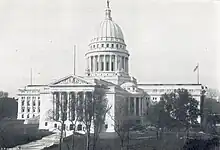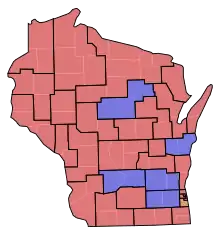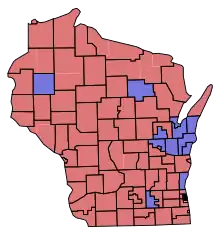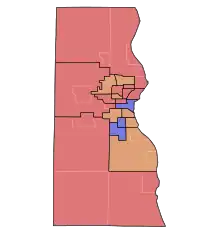| 53rd Wisconsin Legislature | |||||
|---|---|---|---|---|---|
| |||||
 Wisconsin State Capitol ca.1915 | |||||
| Overview | |||||
| Legislative body | Wisconsin Legislature | ||||
| Meeting place | Wisconsin State Capitol | ||||
| Term | January 1, 1917 – January 6, 1919 | ||||
| Election | November 7, 1916 | ||||
| Senate | |||||
| Members | 33 | ||||
| Senate President | Edward Dithmar (R) | ||||
| President pro tempore | Timothy Burke (R) | ||||
| Party control | Republican | ||||
| Assembly | |||||
| Members | 100 | ||||
| Assembly Speaker | Lawrence C. Whittet (R) | ||||
| Party control | Republican | ||||
| Sessions | |||||
| |||||
| Special sessions | |||||
| |||||
The Fifty-Third Wisconsin Legislature convened from January 10, 1917, to July 16, 1917, in regular session, and re-convened in two special sessions in February and September 1918.[1]
During this session, the new Wisconsin State Capitol was completed after 13 years of reconstruction following the 1904 fire. The official dedication ceremony was postponed until the end of World War I.[2]
Senators representing even-numbered districts were newly elected for this session and were serving the first two years of a four-year term. Assembly members were elected to a two-year term. Assembly members and even-numbered senators were elected in the general election of November 7, 1916. Senators representing odd-numbered districts were serving the third and fourth year of a four-year term, having been elected in the general election of November 3, 1914.[1]
Major events
- January 11, 1917: The Kingsland explosion destroyed approximately 500,000 rounds of artillery ammunition in Lyndhurst, New Jersey.
- February 1, 1917: The German Empire announced that it would resume unrestricted submarine warfare, rescinding the Sussex pledge.
- February 3, 1917: The United States severed diplomatic relations with Germany.
- February 24, 1917: British intelligence shared the Zimmermann Telegram with American Ambassador Walter Hines Page, in which the German Empire proposed a military alliance with Mexico if the United States entered the war against Germany.
- March 4, 1917: Second inauguration of President Woodrow Wilson.
- March 15, 1917: Following the February Revolution, Tsar Nicholas II abdicated his throne, bringing an end to the Russian Empire.
- April 3, 1917: Walter C. Owen was elected justice of the Wisconsin Supreme Court, defeating incumbent justice Roujet D. Marshall.
- April 6, 1917: The United States declared war on the German Empire, beginning their active participation in World War I.
- April 26, 1917: The Wisconsin Senate voted to expel senator Frank Raguse after he refused to affirm his allegiance to the United States. Raguse remains the only member of the Wisconsin State Legislature to have been expelled.
- May 18, 1917: U.S. President Woodrow Wilson signed the Selective Service Act of 1917, giving the president the power of conscription.
- June 15, 1917: U.S. President Woodrow Wilson signed the Espionage Act of 1917, to prevent interference with U.S. war activities or promoting the interests of U.S. war opponents.
- July 18, 1917: Regiments of the Wisconsin National Guard were activated and organized into the 32nd Infantry Division for federal service.
- October 6, 1917: The first University of Wisconsin football game to be played at Camp Randall Stadium.
- October 21, 1917: Wisconsin's junior United States senator, Paul O. Husting, died in a hunting accident.
- November 7, 1917: Amidst the October Revolution in Russia, workers stormed the Winter Palace and destroyed the Russian Provisional Government, triggering the Russian Civil War.
- November 24, 1917: A bomb killed 9 members of the Milwaukee Police Department in the most deadly single incident for American police until the September 11 attacks of 2001.
- January 1918: First known cases of Spanish flu were observed in Haskell County, Kansas.
- March 3, 1918: The Treaty of Brest-Litovsk was signed between the Russian Soviet Federative Socialist Republic and the Central Powers, ending Russia's involvement in World War I.
- April 2, 1918: Irvine Lenroot was elected United States senator from Wisconsin in a special election.
- May 18, 1918: Wisconsin's mobilized regiments in the 32nd Infantry Division arrived at the western front of World War I and continued on the line until the end of the war.
- November 5, 1918: Emanuel L. Philipp was re-elected Governor of Wisconsin, his third term.
- November 9, 1918: Kaiser Wilhelm II abdicated his throne, ending the German Empire. The German Republic was proclaimed as successor state.
- November 11, 1918: The German Republic agreed to an armistice with the Entente, effectively ending major combat in World War I.
- December 4, 1918: U.S. President Woodrow Wilson departed to attend the Paris Peace Conference, becoming the first sitting U.S. president to visit Europe.
Major legislation
- 1917 Joint Resolution 20: Joint Resolution to amend sections 6 and 7, of article VII, of the constitution of the state of Wisconsin, relating to circuit judges, 1917 Joint Resolution 20. First legislative passage of a proposed amendment to the constitution to allow the legislature to reduce the number of judicial circuits and assign multiple judges to single circuits.
- 1917 Joint Resolution 23: Joint Resolution to amend section 21 of article IV of the constitution, relating to compensation of members of the legislature, 1917 Joint Resolution 23. First legislative passage of a proposted amendment to allow legislative salaries to be set by law, rather than fixed by the constitution.
- 1917 Joint Resolution 24: Joint Resolution to provide for the appointment of a joint committee of the legislature to investigate the subject of "Social Insurance", 1917 Joint Resolution 24.
Party summary
Senate summary

| Party (Shading indicates majority caucus) |
Total | ||||
|---|---|---|---|---|---|
| Dem. | S.D. | Rep. | Vacant | ||
| End of previous Legislature | 9 | 1 | 20 | 30 | 3 |
| Start of 1st Session | 6 | 3 | 24 | 33 | 0 |
| From April 27, 1917[note 1] | 2 | 32 | 1 | ||
| Final voting share | 25% | 75% | |||
| Beginning of the next Legislature | 2 | 4 | 27 | 33 | 0 |
Assembly summary

| Party (Shading indicates majority caucus) |
Total | ||||
|---|---|---|---|---|---|
| Dem. | S.D. | Rep. | Vacant | ||
| End of previous Legislature | 29 | 8 | 63 | 100 | 0 |
| Start of 1st Session | 13 | 7 | 80 | 100 | 0 |
| From Feb. 14, 1917[note 2] | 79 | 99 | 1 | ||
| From Apr. 10, 1917[note 3] | 14 | 100 | 0 | ||
| From July 1, 1917[note 4] | 78 | 99 | 1 | ||
| From Dec. 10, 1917[note 5] | 13 | 98 | 2 | ||
| From Dec. 25, 1917[note 6] | 77 | 97 | 3 | ||
| From Jan. 3, 1918[note 7] | 12 | 96 | 4 | ||
| From Feb. 19, 1918[note 8] | 13 | 8 | 79 | 100 | 0 |
| Final voting share | 21% | 79% | |||
| Beginning of the next Legislature | 6 | 16 | 78 | 100 | 0 |
Sessions
- Regular session: January 10, 1917 – July 16, 1917
- February 1918 special session: February 19, 1918 – March 9, 1918
- September 1918 special session: September 24, 1918 – September 25, 1918
Leaders
Senate leadership
- President of the Senate: Edward Dithmar (R)
- President pro tempore: Timothy Burke (R–Green Bay)
Assembly leadership
Members
Members of the Senate
Members of the Senate for the Fifty-Third Wisconsin Legislature:[3]

Members of the Assembly
Members of the Assembly for the Fifty-Third Wisconsin Legislature:[3]


Committees
Senate committees
- Senate Standing Committee on Committees – M. W. Perry, chair
- Senate Standing Committee on Contingent Expenditures – C. H. Everett, chair
- Senate Standing Committee on Corporations – W. M. Bray, chair
- Senate Standing Committee on Education and Public Welfare – M. W. Perry, chair
- Senate Standing Committee on the Judiciary – J. H. Bennett, chair
- Senate Standing Committee on Legislative Procedure – T. Burke, chair
- Senate Standing Committee on State Affairs – W. T. Stevens, chair
- Senate Special Committee on Conservation – F. H. Hanson, chair
- Senate Special Committee on Highways – L. E. Cunningham, chair
Assembly committees
- Assembly Standing Committee on Agriculture – H. J. Grell, chair
- Assembly Standing Committee on Commerce and Manufactures – C. F. Hart, chair
- Assembly Standing Committee on Contingent Expenditures – R. B. Melvin, chair
- Assembly Standing Committee on Education – S. A. Schindler, chair
- Assembly Standing Committee on Elections – G. Carpenter, chair
- Assembly Standing Committee on Engrossed Bills – W. R. Chipman, chair
- Assembly Standing Committee on Enrolled Bills – H. Freehoff, chair
- Assembly Standing Committee on Excise and Fees – J. M. Engebretson, chair
- Assembly Standing Committee on Fish and Game – J. A. Chinnock, chair
- Assembly Standing Committee on Insurance and Banking – J. C. Chapple, chair
- Assembly Standing Committee on the Judiciary – A. C. Otto, chair
- Assembly Standing Committee on Labor – D. J. Vincent, chair
- Assembly Standing Committee on Municipalities – J. Dixon, chair
- Assembly Standing Committee on Printing – C. Pieper, chair
- Assembly Standing Committee on Public Welfare – G. D. Whiteside, chair
- Assembly Standing Committee on Revision – C. S. Schiewitz, chair
- Assembly Standing Committee on Rules – E. A. Everett, chair
- Assembly Standing Committee on State Affairs – J. Gamper, chair
- Assembly Standing Committee on Taxation – W. H. Edwards, chair
- Assembly Standing Committee on Third Reading – J. J. Aulenbacher, chair
- Assembly Standing Committee on Transportation – B. Webster, chair
Joint committees
- Joint Standing Committee on Finance – P. Whitman (Sen.) & E. A. Everett (Asm.), co-chairs
Employees
Senate employees
- Chief Clerk: Oliver G. Munson[4]
- Assistant Chief Clerk: C. E. Mullen
- Journal Clerk: James B. Ackley
- Bookkeeper: Carle E. Dietze
- Index Clerk: Don E. Mowry
- Enrolling Clerk: J. K. Kidder
- Revision Clerk: D. J. Hotchkiss
- Clerk of the Committee on Corporations: A. C. Miller
- Clerk of the Committee on Education and Public Welfare: R. H. Hillyer
- Clerk of the Committee on Finance: Arthur F. Steffen
- Clerk of the Committee on the Judiciary: L. G. Vogt
- Clerk of the Committee on State Affairs: A. A. Heinrich
- Stenographers:
- L. Schwartz
- J. W. Leonard
- Typists:
- C. L. Cass
- R. L. Jacobson
- Mailing Clerk: E. G. Cooper
- Sergeant-at-Arms: F. E. Andrews
- Assistant Sergeant-at-Arms: John J. Knudsen
- Document Clerk: Emil Hartman
- Day Police: Albert Daley
- Night Police: Arlie M. Mucks
- Gallery Police: Herman A. Degner
- Night Laborers:
- Thomas R. Foulkes
- Ernest W. Rehnstrand
- Postmaster: Frank E. Riley
- Messengers:
- Paul W. Dietz
- Robert Kilgust
- Earl L. Marsh
- Robert A. Cobban
- John Lorigan
- Ivan P. Donaghey
- Glen A. Buerke
- Lloyd B. Cain
- Messengers:
Assembly employees
- Chief Clerk: C. E. Shaffer[4]
- Journal Clerk: W. W. Jones
- Assistant Journal Clerk: J. S. Miller
- Bookkeeper: W. J. Goldschmidt
- Assistant Bookkeeper: J. C. Hawker
- General Clerks:
- W. F. Bart
- L. J. Federer
- Index Clerk: Edwin M. Johnson
- Proofreaders and Enrolling Clerks:
- Geo. F. Sharpe
- Edward Oakey
- Mailing Clerk: Edwin L. Shaffer
- Stenographers:
- Alvah V. Gruhn
- L. M. Mielke
- Emil Lusthaus
- H. J. Campaign
- N. E. Lummerding
- P. J. Knippel
- Victor Gilbertson
- William L. Wollin
- O. B. Lovell
- Earl L. Dole
- Joseph Entringer Jr.
- Warren H. Schwartz
- Typists:
- L. L. Oeland
- H. S. Belowsky
- Journal Clerk: W. W. Jones
- Sergeant-at-Arms: Thomas Grant Cretney
- Assistant Sergeant-at-Arms: Ernest F. Wright
- Document Room Custodian: Helmer O. Femrite
- Assistant Document Room Custodian: John D. Morner
- Floor Police: Peter Duex
- Cloak Room Attendant: John Holm
- Gallery Police:
- C. H. Sanderson
- A. H. Emerson
- Night Laborer: Hilding E. Anderson
- Night Watch: Elmer R. Meacham
- Postmaster: Clarence O. Livermore
- Post Office Messenger: Marshall M. Arnold
- Messengers:
- Helmer Hembre
- Burr C. Wilcox
- B. J. Glass
- William Crapser
- Austin Johnson
- Leo Levenick
- Isadore Perstein
- Casper Jaquish
- Orville Radke
- Henry Royce
- C. H. Meister
- Carl Isaacson
- Arthur Thorpe Jones
- Ray J. Carey
Notes
- ↑ Socialist Frank Raguse (District 8) was expelled after refusing to sign a statement affirming his allegiance to the United States.
- ↑ Republican Isaac J. Kvam (Barron County) died February 14, 1917.
- ↑ Democrat Charles A. Beggs (Barron County) was sworn in to replace Isaac J. Kvam on April 10, 1917.
- ↑ Republican Edward A. Everett (Iron & Vilas counties) resigned.
- ↑ Democrat William Arnemann (Winnebago County) died.
- ↑ Republican D. S. Burnett (Marathon County) resigned.
- ↑ Democrat Carl Hansen (Manitowoc County) died.
- ↑ Democrat Walter Wittman (Manitowoc County), Socialist Herman Marth (Marathon County), and Republicans Griffith Thomas (Iron & Vilas counties) and Publius Lawson (Winnebago County), were sworn in to fill vacancies.
References
- 1 2 Barish, Lawrence S.; Lemanski, Lynn, eds. (2021). "Historical Lists" (PDF). State of Wisconsin Blue Book 2021–2022 (Report). Wisconsin Legislative Reference Bureau. pp. 467, 471, 475, 479–480. ISBN 978-1-7333817-1-0. Retrieved March 11, 2023.
- ↑ "Cost of New Capitol is Fixed at $7,044,000; Building Now Complete". Wisconsin State Journal. August 12, 1917. p. 2. Retrieved April 28, 2023 – via Newspapers.com.
- 1 2 "Biographical Sketches". The Wisconsin Blue Book 1917 (Report). Industrial Commission of Wisconsin. 1917. pp. 495–557. Retrieved April 28, 2023.
- 1 2 "Organization of Legislature of 1917". The Wisconsin Blue Book 1917 (Report). Industrial Commission of Wisconsin. 1917. pp. 490–493. Retrieved April 28, 2023.